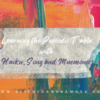Dosa, Idli and Science

Dosa and Idli – Two common breakfast or snack options. Though it originated in south India, now you can find these two even in US and European restaurants. Chefs have been continuously reinventing these two by adding new flavors and altering the ingredients. At restaurants we get Plain dosa to Chicken tikka masala dosa.
Have you ever thought on how the batter of idli, dosa gets fermented as you are not adding any inoculate or microbe culture as in making curd or baking bread. All credit goes to microbes L. mesenteroides and S. faecalis.
Idli dosa includes only two main ingredients: ‘Lentils'(Urad dal/Black gram) and ‘Rice'(Parboiled rice- pre processed rice, reducing the time required to soak before grinding). Some add even few grains of fenugreek.
Once the ingredients are ground after soaking they are kept mostly overnight (30-32deg celcius). Lactic acid bacteria L. mesenteroides and S. faecalis develop during soaking, then continue to multiply following grinding. L. mesenteroides is the microorganism essential for leavening of the batter and, along with S. faecalis is also responsible for acid production.
There have been reports of other Lactobacillus strains and wild yeasts. (inoculum in this case is from grain and gram surface and from atmosphere, so it is bound to have mixed strains). While yeasts are known to facilitate alcoholic fermentations, lactic acid bacteria produce lactic acid. Black gram soaked in water has high concentration of soluble nutrients to support the growth of lactic acid bacteria. The role of lactic acid bacteria is to reduce pH of the batter to an optimum level (4.4 to 4.5) for yeast activity.The reported changes during fermentation include an increase in free sugar, non-protein nitrogen, free nicotinic acid methionine and choline .
Idli/Dosa facts:
A recipe for dosa (as dosaka) can be found in Manasollasa, a 12th-century Sanskrit encyclopedia.
624 varieties of Dosas! have been reported
 The longest dosa measures 16.68 m (54 ft 8.69 in) and prepared by Hotel Daspalla (all India), at the Forum Sujana Mall, in Hyderabad, Telangana, India, on 16 November 2014
The longest dosa measures 16.68 m (54 ft 8.69 in) and prepared by Hotel Daspalla (all India), at the Forum Sujana Mall, in Hyderabad, Telangana, India, on 16 November 2014
During fermentation, vitamin B and C increases
The vitamins content of batter per 100 g are 0.59 mg riboflavin, 0.59 mg thiamine and 0.76 mg folic acid
Avoid using chlorinated water as it can kill yeasts. Use boiled or filtered water.
Iodine present in salt can destroy yeast. So it’s better to use non-iodized salt such as ‘Kosher salt’
Dosa variants from Indian states:
- Tamil Nadu – Dosa/Dosai/Utthappam
- Karnataka – Set Dosa/Benne Dosa/Uppu Huli Dosa/ Pathrode Dosa
- Andhra Pradesh – Pesarattu
- Kerala – Thattil Kutti Dosa
- Odisha – Chakuli Pitha
Go ahead and make the best idli/dosa and share the science facts…..








